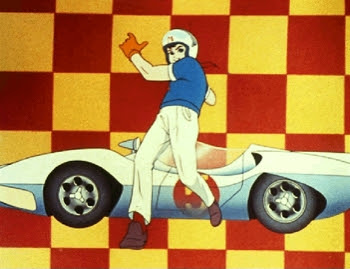
Speed Racer is the title of an English adaptation of the Japanese cartoon Mach Go Go Go which centered around automobile racing. The series is an early example of an anime becoming a successful franchise in the United States.
The characters and storylines originated in Japan as the manga and anime series Mach Go Go Go (マッハGoGoGo) from the anime studio Tatsunoko Productions.
Mach Go Go Go was first created by anime pioneer Tatsuo Yoshida (1933–1977) as a manga series in the 1960s and made the jump to TV as an anime series in 1967. The central character in the anime and manga was a young race car driver named Gō Mifune (三船剛 Mifune Gō). Yoshida selected the names and symbolisms in his creation very carefully. The M logo on the hood of his race car and the front of his helmet stood for his family name Mifune, an homage to Japanese film star Toshiro Mifune (and not "Mach 5" as the dub would suggest). His given name Gō is also a Japanese homonym for the number 5 (the number on his race car). This is also represented by the letter G embroidered on his shirt. The names themselves constitute a multi-lingual wordplay of the kind that started to become part of the Japanese popular culture of the time.
The English rights to Mach Go Go Go were immediately acquired by American syndicator Trans-Lux. The main character Go Mifune was given the name "Speed Racer" in the English version. A major editing and dubbing effort was undertaken by producer Peter Fernandez, who also voiced many of the characters, including Speed Racer himself. Fernandez was also responsible for a retooling of the theme song's melody and its subsequent English lyrics. When the series emerged before U.S. TV audiences as Speed Racer, fans were quickly drawn to its sophisticated plots involving fiendish conspiracies, violent action, hard-driving racing, and soulful characters with sparkling eyes. In an effort to squeeze the complicated plotlines into existing lip movements, the frenetic pace of the dubbing made Speed Racer famous for its quirky "fast" dialogue. In the late 1990s the series made a comeback as reruns on Cartoon Network in late afternoon (and later on in late night/overnight) programming. The series was distributed in the 1990s by Group W's international unit with the mention of Trans-Lux deleted from the show's opening sequence.
The characters and storylines originated in Japan as the manga and anime series Mach Go Go Go (マッハGoGoGo) from the anime studio Tatsunoko Productions.
Mach Go Go Go was first created by anime pioneer Tatsuo Yoshida (1933–1977) as a manga series in the 1960s and made the jump to TV as an anime series in 1967. The central character in the anime and manga was a young race car driver named Gō Mifune (三船剛 Mifune Gō). Yoshida selected the names and symbolisms in his creation very carefully. The M logo on the hood of his race car and the front of his helmet stood for his family name Mifune, an homage to Japanese film star Toshiro Mifune (and not "Mach 5" as the dub would suggest). His given name Gō is also a Japanese homonym for the number 5 (the number on his race car). This is also represented by the letter G embroidered on his shirt. The names themselves constitute a multi-lingual wordplay of the kind that started to become part of the Japanese popular culture of the time.
The English rights to Mach Go Go Go were immediately acquired by American syndicator Trans-Lux. The main character Go Mifune was given the name "Speed Racer" in the English version. A major editing and dubbing effort was undertaken by producer Peter Fernandez, who also voiced many of the characters, including Speed Racer himself. Fernandez was also responsible for a retooling of the theme song's melody and its subsequent English lyrics. When the series emerged before U.S. TV audiences as Speed Racer, fans were quickly drawn to its sophisticated plots involving fiendish conspiracies, violent action, hard-driving racing, and soulful characters with sparkling eyes. In an effort to squeeze the complicated plotlines into existing lip movements, the frenetic pace of the dubbing made Speed Racer famous for its quirky "fast" dialogue. In the late 1990s the series made a comeback as reruns on Cartoon Network in late afternoon (and later on in late night/overnight) programming. The series was distributed in the 1990s by Group W's international unit with the mention of Trans-Lux deleted from the show's opening sequence.
